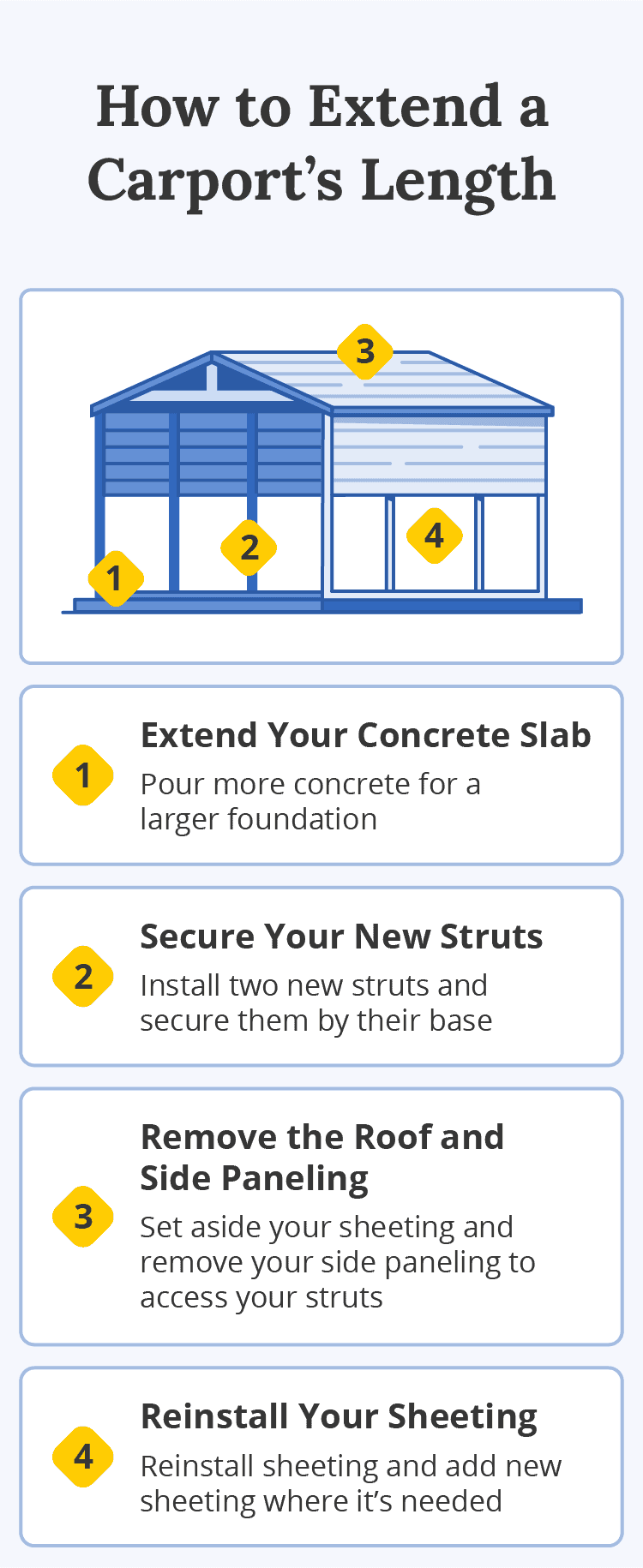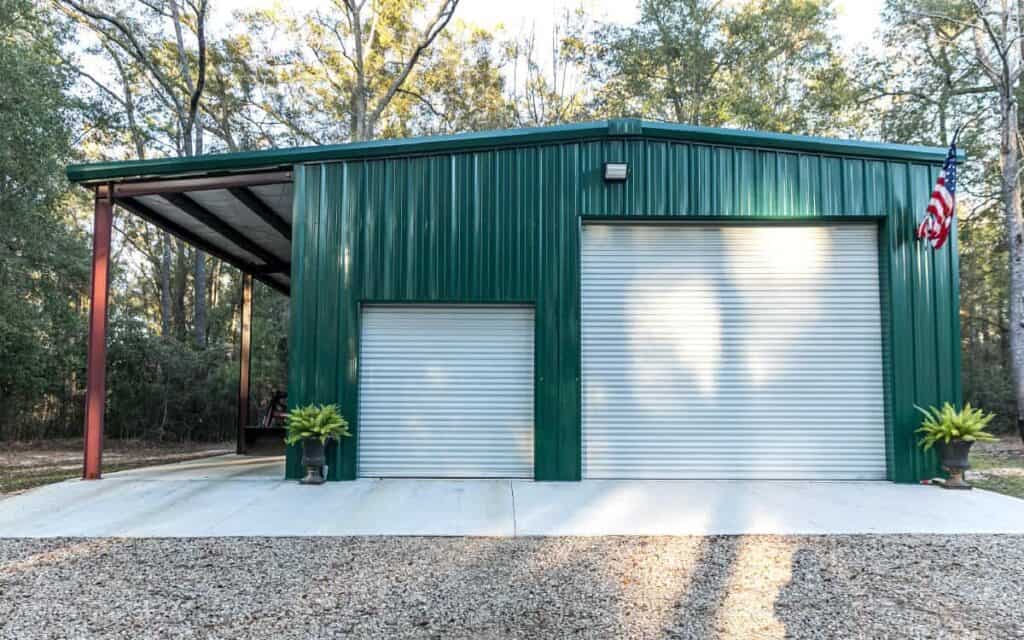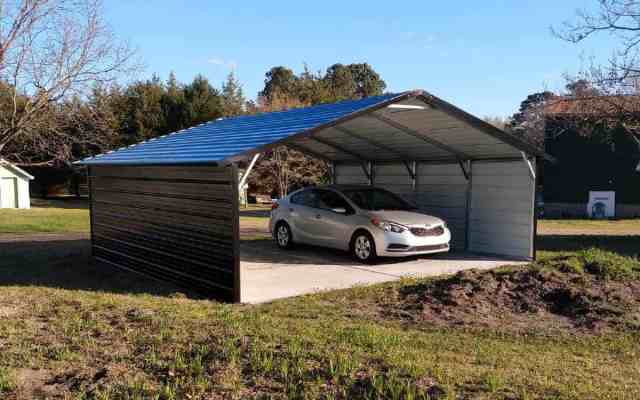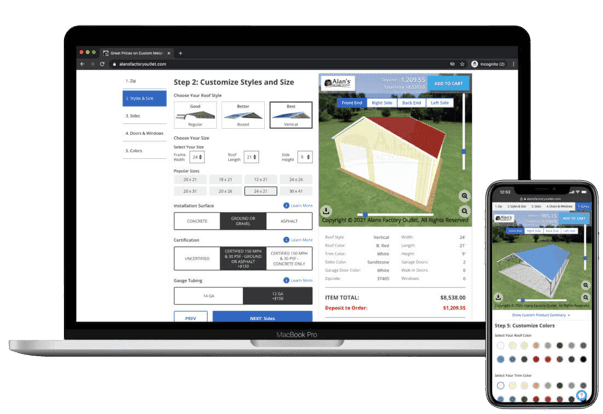If you’re running out of parking space or need more clearance for your specialty trailer, extending your carport is a great solution. Unlike building an entire carport from the ground up, adding an extension takes less time and money, not to mention much easier if you have a metal carport.
To help you plan your building project, we’ll show you three carport extension methods and factors to know before getting started.
Extending Length
Sometimes, the standard carport length isn’t enough to cover longer vehicles like RVs and boats. In this case, you’ll want to extend the length of your carport by following the steps below:
- Remove your roof and side paneling: Set aside your sheeting and remove your side paneling so you can access your carport’s struts.
- Extend your concrete slab: Before you add struts to support the added length of your carport, you may need to pour more concrete to extend your slab.
- Secure new struts: Install two new struts and secure them by their base—similar to your existing struts.
- Reinstall sheeting: Reinstall the sheeting you set aside earlier and install new sheeting to cover the added space of your carport.

Extending Height
Standard carports typically have legs that are seven feet high with a center height of 12 feet, which might not accommodate larger RVs or travel trailers. To raise the height, you’ll need the right carport leg extensions and jacks.
You can search for carport leg extensions at your local retailers or directly contact your carport manufacturer to see if they sell specifically-built extensions. Then, you’ll likely want to find three large A-frame jacks at your local hardware store.
Before you install your extensions, remove your carport’s roof to make it easier and lighter to lift. Then, lift one side with your three jacks and install your extensions on the opposite side. Once finished, work on the side you initially lifted.
Finally, you can reinstall your roof, and your structure should be ready to go.
Install a Lean-To
Instead of extending your existing structure, adding a lean-to is a simpler way to add width. It won’t perfectly match your carport’s original design but will add extra coverage for parking space.
Before you begin, extend your carport slab so any new struts you erect have a proper foundation.
Installing a lean-to involves erecting new support posts to bear one side of the structure while the other side leans against your carport’s roof. Before you begin, you’ll need to expand and reinforce the foundation of your carport to support additional weight.

Lean-to installation may also require you to remove some of your roof sheeting before attaching the structure. After securing the support beams of your lean-to, you can reinstall the sheeting.
Tip: To learn more about proper reinforcement, check out our guide on how to anchor a carport.
Considerations Before Extending Your Carport
Extending your carport can be a costly and time-consuming process if not performed properly. Before you begin the process, here are a few important factors to keep in mind:
Permits and Zoning Laws
Your local government or HOA will likely have regulations surrounding building extensions. Call your local zoning department to see if your area requires building permits for the process.
Purpose
Determine the purpose of your carport to determine what adjustments you should make and how much it will cost. Otherwise, you might adjust the height of your carport only to realize your RV sticks out at the end—meaning you’ll need to spend more money and time to adjust its length, too.
Cost
The cost of extending your carport will vary depending on the materials, adjustments you need to make, and labor fees if hiring a contractor. Ensure your budget allows for the necessary materials before you begin building.
Location
If you plan on moving from your location anytime soon, consider waiting before committing to a large building project. Extending a carport or adding a lean-to can be a big time and money investment for something temporary.
Alternative Option: Customize a New Carport
If these extension methods don’t work for you or you don’t have enough time to do them yourself, consider ordering a new carport or garage from Alan’s Factory Outlet. Use our 3D garage and carport builder to build and price your dream building—we’ll take care of the delivery and installation for free.




